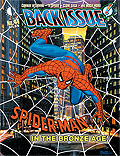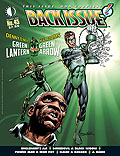“…Just a Man Called Cage!”
Gerry Conway/Gil Kane & Johnny Romita-J. Romita & Tony Mortellaro
NOTE: This review was originally published on November 5, 2009.
Doug: One of the hallmarks of Marvel Comics has always been the conflict between its heroes. Sure, team-ups are another noted trademark – but usually not without an at least brief round of fisticuffs first. With this post, we’d like to begin an intermittent series on those fun stories where Marvel’s heroes met up and an inevitable brouhaha ensued.

Doug: Of course, ASM #123 follows just a month after arguably the most important 2-part story of the entire Bronze Age – the deaths of Gwen Stacy and the Green Goblin. Both deaths are revisited, though not in flashback form. This issue contains the funeral of Gwen Stacy, and the revelation that a mysteriously shrouded stranger had removed the Goblin costume from the body of Norman Osborn.

Doug: So, how exactly do Mr. Luke Cage and our hero become entangled? J. Jonah Jameson, while riding away from the scene of Osborn’s death, spies a newspaper article about one Hero for Hire. ASM #123 was on the shelves and spinner racks the same month as Hero for Hire #12 – which was initially published bi-monthly; Cage had been around for about a year and a half.

Jonah pays a visit to Cage’s rundown movie theater-headquarters, to find Cage dismissing a potential employer in quite physical fashion. Undeterred, Jonah offers Cage the job, and we proceed from there.
 Karen: That whole sequence just reminds me of so many black exploitation films from the 70s – Shaft, Superfly, the Mack – I think Gerry Conway must have seen a few! But doesn’t $5000 seem like a paltry sum for taking down Spidey?
Karen: That whole sequence just reminds me of so many black exploitation films from the 70s – Shaft, Superfly, the Mack – I think Gerry Conway must have seen a few! But doesn’t $5000 seem like a paltry sum for taking down Spidey?
Doug: I always have to laugh at things like that – they really date the comics! You know, we’ve recently discussed Randy Robertson as an “angry black man” stereotype – Cage fits this bill as well. Thank goodness for the calming presence of Joe Robertson throughout these years.

Doug: Conway does a really nice job of showing the pain of the characters at Gwen’s funeral, and the anger and psychological turmoil of Harry Osborn over the loss of his father. These elements of characterization, of drawing the reader into the lives of these characters, was one very important ingredient missing from the two Iron Man issues we recently reviewed.
Karen: Conway did maintain that aspect of the book pretty well. You’d have to be an idiot not to realize that the key to any Spidey title is his personal life!
Doug: Gil Kane and John Romita share penciling credits on this story – it’s unclear who the plotter was, but either artist moves a story well. This issue is no exception. The battle scenes between Spider-Man and Cage are very well-choreographed and believable. Spidey quickly assesses Cage’s strength and near-invulnerability. The first round ends in a Spidey victory, but the interim is short-lived.
 Karen: I agree, it’s an exciting sequence. The artwork here is interesting – the inks seem sort of heavy, and rough, and yet it is really dynamic. A couple of things caught my attention. One is that Cage really did do some detective work, figuring out where Spidey had been seen most often and waiting for him.
Karen: I agree, it’s an exciting sequence. The artwork here is interesting – the inks seem sort of heavy, and rough, and yet it is really dynamic. A couple of things caught my attention. One is that Cage really did do some detective work, figuring out where Spidey had been seen most often and waiting for him.  But then he does something unprofessional: he tells Spidey who hired him! I also liked the tension between them when Spidey calls Cage a mercenary, which brings a more personal angle to the fight.
But then he does something unprofessional: he tells Spidey who hired him! I also liked the tension between them when Spidey calls Cage a mercenary, which brings a more personal angle to the fight.
Doug: The second battle is again fierce and well-thought. I did wonder, however, at the conclusion when Spidey is able to restrain Cage with his webbing. It seemed to me that Cage would have been able to burst those bounds. But it all worked to set up a nice ending, with Cage deciding to listen to Spidey’s logic.
 Karen: Spidey does mention that Cage could break the webbing “in a few minutes” so I don’t think there was any disparagement on Cage’s strength. I have to say though, that shot of him webbed down is terrible – Cage’s face looks bestial and kind of made me wince.
Karen: Spidey does mention that Cage could break the webbing “in a few minutes” so I don’t think there was any disparagement on Cage’s strength. I have to say though, that shot of him webbed down is terrible – Cage’s face looks bestial and kind of made me wince.

Doug: And the ending was a nice bit of physical comedy, very much a relief from the high emotions of the previous two issues, and indeed of scenes earlier in this very issue.

I did feel, however, that the seeds of romance Conway was planting between Pete and Mary Jane was happening way, way too soon.
Doug: Gerry Conway may be the best of the Marvel Bronze Age scribes. Certainly he would get a run for the money from Steve Englehart. But, after having examined the work of Roy Thomas and Friedrichs Mike and Gary recently, I would favor Conway.
Karen: This is where we part ways – I’d choose Englehart or Thomas over Conway in a heartbeat. I think Englehart had a much better grasp of emotions, while one of Thomas’s strengths has always been solid plotting. Based on a number of Conway stories I’ve read, I wouldn’t say his plots always seemed coherent to me. But I do think he ranks towards the top of the Bronze Age writers.
Doug: My main complaint about Roy would be his ability to find characters’ voices. I think when he had his long runs on the Avengers and Conan that he had those casts nailed down pretty well. But his earliest forays into the FF and Spidey seemed to drag on a bit until he’d attained a level of comfort with the varying personalities. But as a plotter, I’d generally agree with you. And Englehart – really outstanding.















































































































